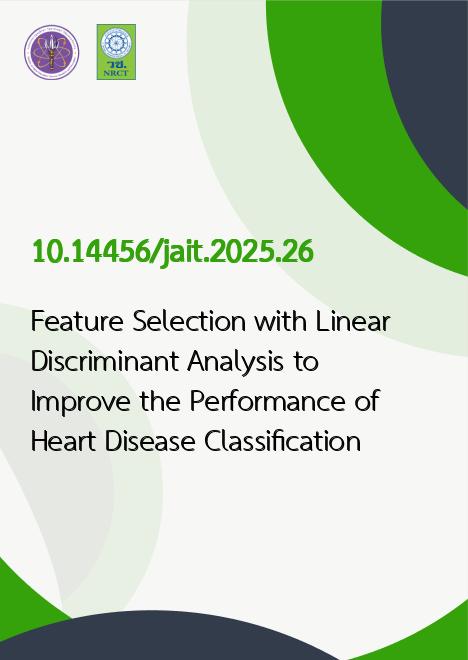
|
Feature Selection with Linear Discriminant Analysis to Improve the Performance of Heart Disease Classification |
|---|---|
| รหัสดีโอไอ | |
| Creator | Ratiporn Chanklan |
| Title | Feature Selection with Linear Discriminant Analysis to Improve the Performance of Heart Disease Classification |
| Contributor | Keerachart Suksut, Kedkarn Podhijittikarn |
| Publisher | Faculty of Informatics, Mahasarakham University |
| Publication Year | 2568 |
| Journal Title | Journal of Applied Informatics and Technology |
| Journal Vol. | 7 |
| Journal No. | 2 |
| Page no. | 432-447 |
| Keyword | Heart Disease, Feature Selection, Linear Discriminant Analysis |
| URL Website | https://ph01.tci-thaijo.org/index.php/jait |
| Website title | Journal of Applied Informatics and Technology |
| ISSN | 3088-1803 |
| Abstract | Artificial intelligence (AI) technology has become increasingly popular and is widely applied across various fields. In the medical domain, AI has been employed to support disease diagnosis. Heart disease is a common condition that affects individuals of all genders, ages, and races, and remains a leading cause of mortality worldwide. Currently, the diagnosis of heart disease can be performed using AI by leveraging electrocardiogram (ECG) data in combination with machine learning algorithms. However, in some cases, the number of data features required is excessive, which may reduce model performance. In this research, we propose a feature selection method based on Linear Discriminant Analysis (LDA) to improve the classification accuracy of a heart disease dataset. The proposed method is compared with two other feature selection techniques: correlation-based selection and information gain. We then construct classification models using three algorithms: logistic regression, support vector machines (SVM), and artificial neural networks (ANN). The experimental results show that the proposed technique improves the average classification accuracy from 77.82% to 86.46%, representing an 11.10% increase. The highest classification accuracy of 87.39% is achieved when combining ANN with LDA. The researcher employed this technique to develop a program for assessing the risk of coronary heart disease. The program assists in screening individuals at high risk and provides users with personalized information regarding their likelihood of developing the disease. |